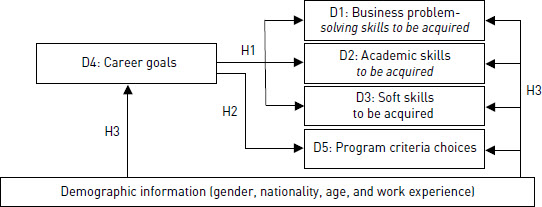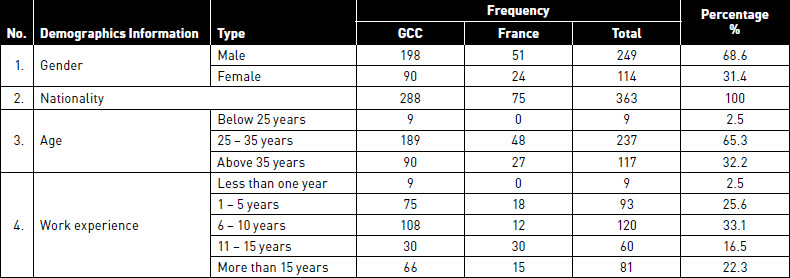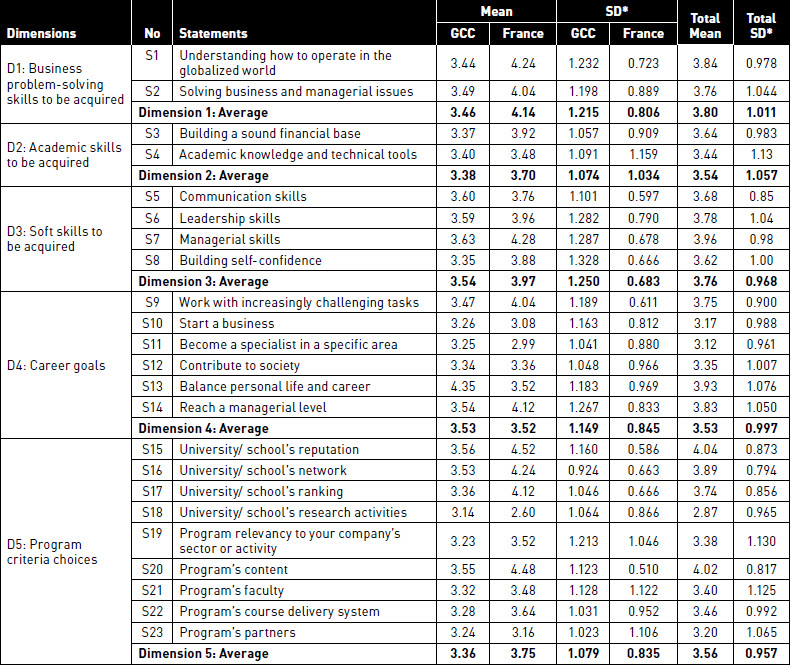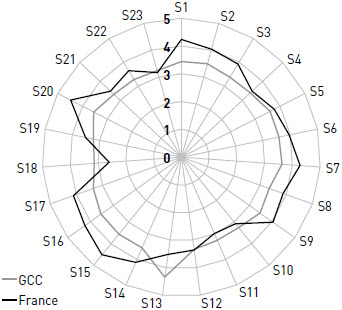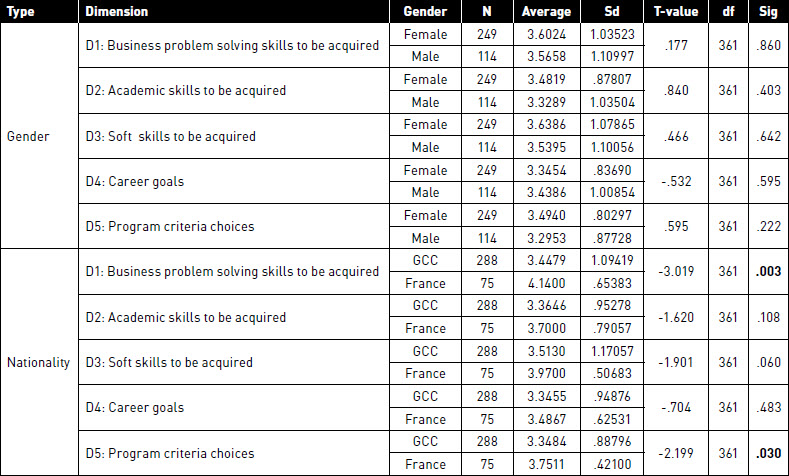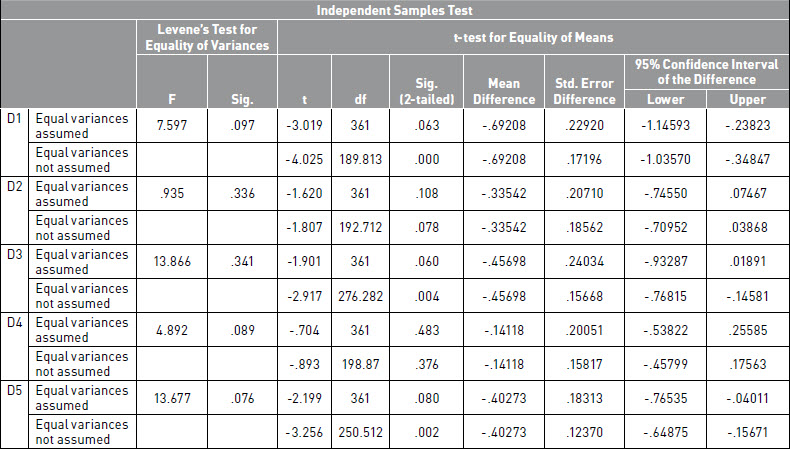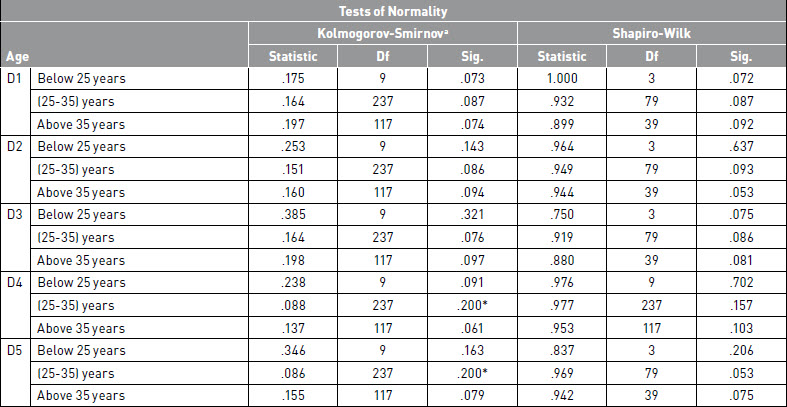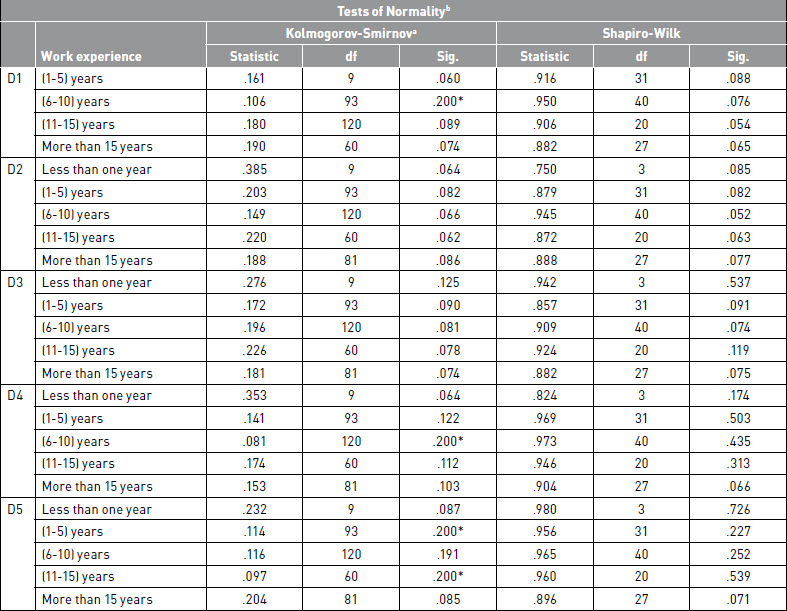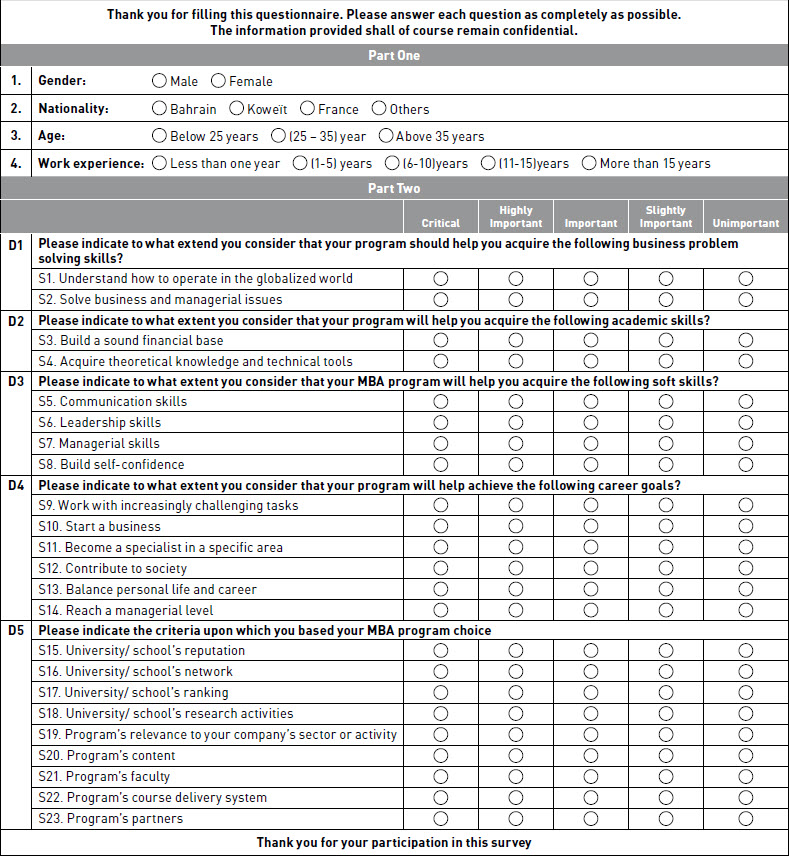Abstracts
Abstract
Relying on two diverse samplings of MBA students – one from an international French business school and the other from a university based in Bahrain that recruits students from the Arabian Gulf countries – our article analyzes the relationship between the MBA students’ career goals and their nationality. Our key findings highlight that nationality has little effect on graduate students' motives for pursuing education, their perception of the expected program outcomes and their career perspectives. Other findings, however, reveal some differences based on nationality, the most significant being program criteria choices in relation to career goals and the expected skills students wished to acquire.
Keywords:
- Business management education,
- MBA,
- Career goals,
- Professional skills,
- Cross-cultural management,
- Gulf region
Résumé
En s’appuyant sur un échantillon d’étudiants à la fois d’une école de commerce française et d’une université établie à Bahreïn et recrutant des étudiants des différents pays arabes du Golfe, notre papier procède à l’analyse des relations entre les objectifs de carrière des étudiants et leur nationalité. Les principaux résultats montrent que la nationalité a peu d’effet sur les motivations des étudiants pour poursuivre leur formation, sur leurs perceptions des résultats qu’ils en attendent ainsi que sur leurs perceptions de leurs perspectives de carrière. En revanche, certains résultats font apparaître des différences en lien avec la nationalité; le plus significatif étant les critères de sélection de programme en relation avec les objectifs professionnels ainsi que les compétences souhaitées.
Mots-clés :
- Formation au management des entreprises,
- MBA,
- Objectifs de carrière,
- Compétences professionnelles,
- Management interculturel,
- Région du Golfe
Resumen
Tomando una muestra de estudiantes de una escuela de comercio francesa y otros de una universidad de Bahreïn que recibe estudiantes de diferentes países árabes del Golfo, este artículo procede al análisis de las relaciones entre las metas profesionales de los estudiantes y sus nacionalidades. Los principales resultados muestran que la nacionalidad tiene escaso efecto en los motivos de los estudiantes para seguir su formación, en los resultados esperados y en su percepción de su perspectiva de carrera. En cambio, algunos resultados muestran diferencias en relación con la nacionalidad: lo más significativo se refiere a los criterios para la elección de programa en relación con los objetivos profesionales y las competencias deseadas.
Palabras clave:
- educación en administración de empresas,
- MBA,
- metas profesionales,
- habilidades profesionales,
- gestión intercultural,
- Países árabes del Golfo
Article body
Pursuing advanced degrees is considered one of the key ways to enrich skills (Grubb, 1993) and acquire knowledge, both of which enhance employees’ careers (Sparrow and Cooper, 2003). In this context, there is a general perception that an MBA can improve access to career opportunities as well as increase self-confidence, which is a valuable form of career capital (Sturges et al., 2003). Baruch et al. (2005) found that employee status just before and just after graduate school increased more for MBA holders than for any other management master student. Thus, an MBA holder will gain leadership skills, which will enable him or her to manage organizations effectively (Baruch and Peiperl, 2000) and consequently join upper managerial ranks (Carnall, 1992).
The expected outcomes include, in addition to the knowledge and skills gained through the educational process, improvement in work outcomes (Naquinand Holton, 2003). Recognition by managers or peers, transfer of learning to the workplace (Mathieu and Martineau, 1997) and career capital building of self-confidence open up opportunities for advancement as well as strengthen competitiveness in the job market (Hawkesley 1996, Luker, Bowers and Powers 1989). However, Pfeffer and Fong (2002) show that there is little evidence to support the view that the knowledge acquired in a business program can enhance job careers. In this regard, Mintzberg (2004) questions the ability of traditional MBA programs to enable any business skill development. Globalization also puts huge pressure on business schools which are expected to help build student global skills (Hunter et al., 2006) which will enable them to work effectively and comfortably outside their environment. Career expectations can vary depending on cultural context and values; these can affect career goals and motivation.
In this context, cross-cultural management research can be very useful to better understand differences in cultural values (Hofstede, 1980; Hofstede, 2001; Trompenaars, 1994). However, very little research has been carried out on the impact of cultural values on the career goals of graduates in general, and business graduates in particular. And, what has been carried out has yielded contradictory results. Researchers state that cross-national data research is hard to acquire (Ronen and Shenkar, 1985) and intercultural researchers have clearly concentrated their efforts on only a limited number of world regions (Feghali, 1997). Gooderham and Nordhaug (2001) found no significant differences between European students in terms of cultural values, whereas Harzing (2004) identified specific, differing patterns of career preferences and objectives.
By revealing potential differences in career goals due to nationality, our paper aims to assess the degree of similarity between career goals and job expectations in Europe and in a significantly unstudied region in the Middle East, i.e. the Gulf Cooperation Council (GCC) countries (Bahrain, Kuwait, Saudi Arabia, United Arab Emirates, Qatar, and Oman).
With the expected depletion of its oil and gas resources, the Arab Gulf States have made the choice to focus more and more on the development of knowledge economies; they are now the largest recipients of transnational higher education in the world (Wilkins, 2011). The greater accessibility of higher education for both students and trainees has created new opportunities for GCC nationals to acquire the new skills and knowledge required to successfully perform their work throughout their career. In addition, the need to rely less on foreign labor to meet domestic demand due to the implementation of labor market nationalization programs (Donnand Al Manthri, 2010) has contributed to the creation of new career and development opportunities for GCC nationals who can more easily target high income positions. Differences between Western and GCC labor markets may impact career goals and the related learning paths required to take full advantage of specific employment opportunities. Given that French and Arab managers score high on both power distance and uncertainty avoidance but that they differ on Hofstede’s individualism/collectivism index, they might have different career development strategies for moving toward their professional objectives.
We analyzed these differences in career goals using a diverse sample of MBA students from a leading international French business school which recruits students from all over the world and from the Arabian Gulf University which recruits students from GCC countries. Gulf countries are attracting prestigious European and American business schools, and these are competing to recruit the best students from the region. At the time of our study, the leading French business school partnered with the Arabian Gulf University to offer an MBA program providing academic guidance and faculty members to teach some of the MBA courses.
The structure of the paper is as follows: we begin by linking literature related to career goals, professional skills development and national differences and we specify our related hypotheses; we then present our research protocol and follow this with a discussion of our results. We conclude by presenting the practical pedagogical implications of our findings and by suggesting future paths of research.
Linking Skill Building to Career Development
It is generally accepted that MBA degrees can lead to quicker track career success in terms of an improvement in salary, hierarchical position, and skills development (Martin and Stains, 1994; Hankinson, 2000). Career success can also be related to acquiring or developing the competencies that are closely linked to personal background characteristics and cultural contexts as well as the dynamics of the work environment (Aryee and Chen 2004). In this regard, Drucker (1985) defines competence at an individual level as the ability of an employee to offer superior performance in tasks. Katz (1955) distinguishes three types of competencies: technical, human and conceptual. Goleman and Boyatzis (2008) have introduced a block of managerial competencies, which involve problem-solving skills, social competencies, communication skills and personal competencies related to personality traits and reliability.
McCollin (2013) shows that business management employees tend to receive promotions at higher rates than their technical counterparts do, even when companies are facing competing demands for field-specific technical workers (Jung and Choi, 2009).
Rubin and Dierdorff (2011) highlight the importance of people management skills, which are highly valued by employers. Oblinger and Verville (1998) underline that problem-solving is important for business graduates. Billing (2007) introduces the concept of “forward reasoning” required to solve problems. The process required to solve a problem includes: retrieving knowledge of the subject, recognizing meaningful patterns and situations and applying general strategies to solve the problem. It is therefore important to develop pedagogical strategies in business higher education programs that will develop these competencies which are required by students.
Career goals or ‘anchors’ (Schein 1985) thus play a key role in the motivation and behavior of students seeking to enroll in an MBA program. Kuijpers et al., (2006) make a clear distinction between intrinsic and extrinsic career success. Intrinsic career success is related to a person’s own appreciation of his or her career actualization whereas extrinsic career success relates to external appreciation, qualified mainly in terms of salary or occupational status. This discussion led us to develop the following hypothesis:
Hypothesis 1 (H1): Career goals have a correlational relationship with business problem-solving skills, academic skills, and soft skills to be acquired.
Linking career goals to business educational program choices
Student interests and motivations for taking part in a graduate business program differ from those related to undergraduate degrees, which tend to rely on a broad knowledge base approach focusing on foundational intellectual skills and aptitudes. Mackenzie (2003) highlights that graduate students tend to concentrate on specialized and advanced programs to reach a higher professional level. More specifically, adult students are more concerned about the transferability of the acquired knowledge to their current organization (Aryee et Chen 2004). Mano-Negrin and Kirschenbaum (1999) show that an important motive for seeking a graduate degree in business can be related to a strategy that maximizes both advancement and learning and personal development objectives. Sturges, Simpson and Altman (2003) demonstrate that MBA students in particular seek career competencies and professional credibility that will enhance their careers. This is consistent with the Hawksley (1996) findings reporting that the primary goal of MBA students was to improve job opportunities. Indeed, business schools can play an important role in shaping the careers of their students and particularly those of MBA participants (Kelan and Jones, 2009) by helping them to progress to senior executive positions, enhancing their employability as well as fast-tracking their careers (Hay and Hodgkinson, 2006).
According to the study conducted by Wellman et al., (2006), MBAs are generally considered better predictors of the managerial success of employees than technical degrees in terms of salary, promotion, and managerial status within an organization. This link is confirmed by the findings of Kochan et al., (2012), which state that MBA holders have more influence and control over strategic decisions that affect their own organization. Increasingly, business schools are expected to build and leverage the capability of managers and leaders by developing their global competencies in the changing environment in which they operate (Stearns, 2009). We thus propose the following hypothesis:
Hypothesis 2 (H2): Career goals affect program criteria choices.
MBA Graduate Expectations and Globalization
Career goals can be defined as the primary end toward which an individual’s effort is directed within a chosen profession or occupation (Colakoglu and Caligiuri, 2012). These goals can vary from one context to another based on national cultural differences (Hofstede, 1991), providing schemes that guide behavior (House and Javidan, 2004) and can be translated in terms of leadership styles, specific needs or motivation. Hofstede (1980, p 25) defines culture as ‘the collective programming of the mind which distinguishes the members of one group or category of people from another’. He analyzes national cultures using four key dimensions: individualism-collectivism, masculinity-femininity, uncertainty avoidance, and power distance. He (op.cit.) establishes a link between education levels and work goals based on the correlation found between education and both individualism and masculinity indices. The formation of a career identity can thus be influenced by different values, needs and goals which are deeply embedded in a national culture (Den Hartog et al., 1999; Feldman and Bolino, 1996). In a review of studies conducted in Arab environments, Rees and Althakhri (2008) highlight the fact that managers are concerned with losing their position and power within their organization and that there is a lack of trust in employees, which is partially related to ineffective communication from the top management. Organizations can help their employees to manage resistance to change by helping them to acquire or upgrade their skills and thus reach their professional and personal goals. The increased emphasis on career development appears to be related to the fact that it can lead to career success, recognition, and satisfaction (Nabi, 1999; Kuijpers et al., 2006).
The success of MBA programs, originating in the USA and then spreading throughout the world (Paton, 2001), is largely due to the fact that the programs were adapted to cultural, geographical locations and individual mindsets (Saba et al., 2011; Rubin and Dierdorff, 2009).
Brown and Jones (2007) highlight the importance of being exposed to other cultures and people to widen the range of a person’s career options. This globalized environment forces business schools to reconsider the key skills and competencies expected from graduates. Thus, educators should clearly distinguish between the academic and non-academic outcomes related to a program (Hoff, 2008) and include assessment methods that allow the measurement of abilities such as critical and analytical thinking as well as abilities related to being able to work and collaborate with people from different cultures (Brunstein, 2006).
Haire et al. (1966) mention the fact that approximately one third of the variance in work goals and managerial attitudes can be explained by the employees’ country of origin. In the Arab world, for example, people are characterized by a high degree of uncertainty avoidance and tend to feel comfortable with the status quo (Mellahi, 2003). Consequently, Jreisat (1990) highlights the necessity to implement a relevant evaluation of employee performance in order to successfully implement change management processes in that area of the world and help to close the gaps by identifying skills and competencies in need of further development. In this context, we can assume that specialized technical skills would be highly valued by Arab societies because they are seen as a way to catch up with Western knowledge and skills which are needed to cope with economic transformation. Based on this, we present the following hypothesis:
Hypothesis 3 (H3): There are statistically significant differences in demographic information (gender, nationality, age, and work experience) in the areas of: business problem-solving skills to be acquired; academic skills to be acquired; soft skills to be acquired; program criteria choices; and career goals.
Building on prior literature, our fieldwork assesses and compares both the relative importance attached to different career goals and the correlational relationship of an MBA degree and career goals among MBA students in relation to their country of origin.
Research Method
Our research is largely descriptive, providing insight into the effect of the MBA degree on career goals. The study population was students from an international French business school and The Arabian Gulf University based in a GCC country.
Drawing on the work of Suutari and Taka (2004), our research protocol aimed at identifying factors influencing MBA program criteria choices such as career goals, desired skill sets and student nationality. Figure 1 shows the schematic diagram of the conceptual model used to test the following hypotheses specified earlier:
H1: Career goals have a correlational relationship with business problem-solving skills, academic skills, and soft skills to be acquired.
H2: Career goals affect program criteria choices.
H3: There are statistically significant differences in demographic information (gender, nationality, age, and work experience) in the areas of: business problem-solving skills to be acquired; academic skills to be acquired; soft skills to be acquired; program criteria choices; and career goals.
Career goals were considered as independent variables for business problem-solving skills to be acquired, academic skills to be acquired, soft skills to be acquired and program criteria choices.
The demographic factors of gender, nationality, age, and experience were considered as independent variables for: business problem-solving skills to be acquired, academic skills to be acquired, soft skills to be acquired, career goals, and program criteria choices.
Our research used a self-administered questionnaire to collect data, based on a 5-point Likert-scale. Likert scales are primarily used in questionnaires to obtain participants’ preferences or degree of agreement with a statement or set of statements (Cohen et al., 2000). The scale used in this paper ranged from 1-5, with unimportant with a value of 1 being the lowest, and critical with a value of 8 being the highest. Bending (1954) highlights that the rater’s reliability is independent of the number on a scale, which starts from five and extends up to nine categories.
The respondents ranked their level of importance with provided statements on a scale of five (1 = unimportant, 2 = slightly important, 3 = important, 4 = highly important, and 5 = critical). The questionnaire was based on nine specific career goals identified by Suutari and Taka (2004): working internationally, working with increasingly challenging tasks, reaching a managerial level, influencing corporate strategies, building a sound financial base, starting a business, becoming a specialist in a specific area, contributing to society, and balancing personal life and career.
The design of the questionnaire of the study was:
Stage One
The initial drafts of the questionnaires were designed and based on the knowledge gained from previous research on the subject (Kelan and Jones, 2009; Sturges, Simpson and Altman, 2003; Hawksley 1996). The questionnaire consisted of two parts; the first part included demographic information questions and the second part covered the five following related themes: business problem-solving skills to be acquired (two statements), academic skills to be acquired (two statements), soft skills to be acquired (four statements), career goals (six statements), and program criteria choices (nine statements).
Stage Two
A preliminary version of the questionnaire was submitted to experts who were asked to evaluate items, syntax, accuracy and clarity. Adjustments were made based on the experts’ feedback to ensure ease of administration of the survey and for validation purposes.
Five scale intervals were used to interpret the respondents’ degree of agreement. The following formula was used to calculate the score interval:
figure 1
Conceptual model with the hypotheses
H1: Career goals have a correlational relationship with business problem-solving skills to be acquired, academic skills to be acquired, soft skills to be acquired.
H2: Career goals affect program criteria choices.
H3: Demographic factors (gender, nationality, age, and work experience) have statistically significant differences on business problem-solving skills to be acquired, academic skills to be acquired, soft skills to be acquired, program criteria choices, and career goals.
Statement average scores of less than1.8 were considered unimportant. Statement average scores from 1.8 to less than 2.6 were considered slightly important. Statement average scores from 2.6 to less than 3.4 were considered important and statement average scores from 3.4 to less than 4.2 were considered highly important. Statement average scores from 4.2 to 5 were considered critical.
The correlations between the dimensions were calculated to measure the direction and the degree of correlation that was rated between -1 and +1. The positive value indicated a positive relationship, and the negative value indicated a negative relationship. The scale of correlation strength (Devore et al. 2013), was as shown in Table 1.
Table 1
Correlation strength
Cronbach’s Alpha was used to measure the internal consistency of the scales used for each key dimension as well as the overall reliability of the questionnaire. The test results showed the following alpha values for the dimensions: 0.747 for business problem-solving skills to be acquired (dimension 1), 0.721 for academic skills to be acquired (dimension 2), 0.932 for soft skills to be acquired (dimension 3), 0.866 for career goals (dimension 4), 0.916 for the program criteria choices alpha (dimension 5). The overall alpha value was 0.967, which indicated that the data was reliable and acceptable for analysis (Pallant, 2008). Table 2 shows that all the values of inter-item correlation were greater than.51. This indicated a moderate coloration between the different dimensions of the study.
Table 2
Inter-Item Correlation
The questionnaire was distributed to the students enrolled in MBA programs both in France and in the GCC. We received 363 valid responses. There were 288 from the GCC (79.3%) and 75 from France (20.7%).
Descriptive statistics (mean and standard deviation) for making a comprehensive summary of data and inferential statistics were used for research statement exploration and for variance analysis.
Results, Analysis and Discussion
In this section, we describe the analysis performed on the collected data to prove the hypotheses of the study and discuss the results.
Table 3 shows the frequency and percentages of the respondents’ demographic information with two general questions. The gender distribution was 249 (68.6%) males and 114 (31.4%) females. The nationality distribution for the GCC participants numbering 288 students (79.3% of the sample) was as follows: 160 (44.0%) were Bahraini, 120 (33.1%) were Kuwaiti, 4 (1.1%) were from Saudi, 4 (1.1%) were from Qatar. The majority of the respondents (354) (97.5%) were over the age of twenty-five and had at least six years of work experience (261(71.9%).
Table 4 shows the averages and standard deviations for each statement of the five dimensions. The first dimension focused on the business problem-solving skills to be acquired by MBA participants. The average of the two statements of this dimension was 3.80 and standard deviation was 1.011 which was ranked highly important. The French students appeared to be interested in technical skills and in working internationally: the “Understanding how to operate in the globalized world” statement obtained 4.24, which ranked very high, while for the GCC students this item had a mean average of 3.44.
The second dimension focused on academic skills to be acquired by MBA participants. The average of the two statements of this dimension was 3.54 and standard deviation was 1.057, which was ranked highly important. The “Technical skills” statement had the highest mean value of 3.44, considered as highly important.
The third dimension covered soft skills to be acquired by MBA participants. The average of the four statements of this dimension was 3.76 and standard deviation was 0.968, which was ranked highly important. This dimension included the “managerial skills” statement which had the highest mean value of 3.96 (considered highly important). A mean of 4.28 was attributed to this statement by the French students and 3.63 by the GCC students. This indicated that all the MBA candidates highly valued managerial skills through education.
The fourth dimension covered MBA participants’ career goals. The average of the six statements of this dimension was 3.53 and standard deviation was 0.997 which was ranked highly important. The “balance personal life and career” statement had the highest mean value of 3.93, which was considered highly important, particularly for the GCC students who assigned an average mean of 4.35 to this item.
The fifth dimension focused on the program criteria choices for MBA participants. The average of the nine statements of this dimension was 3.56 and standard deviation was 0.957, which was ranked highly important. The “university/school’s reputation” statement had the highest mean value of 4.52 for the French students and 3.56 for the GCC students. This indicated that the university/school’s reputation was a key criterion for French and GCC students applying for MBAs. However, the statement “university/school’s research activities” obtained the lowest average of 2.87 which indicated that research activities conducted by business schools were not considered as a key item by either group.
Table 3
Demographic Profile of Respondents
Table 4
Means and standard deviations of the five dimensions
Fig. 2 shows comparisons between GCC and French respondents to the five key dimensions addressed by the questionnaire. The figure shows that the French MBA participants had higher averages compared to those from the GCC for all the statements except for statements S10, S11, S18, and S23.
FIGURE 2
Respondent statement comparison between GCC and French students
Table 5 shows the testing of H1 by using a simple Pearson correlation. The results show that the correlational relationship between career goals and business problem-solving skills to be acquired, academic skills to be acquired, and soft skills to be acquired were significant for both GCC and French respondents. For GCC respondents, career goals correlated significantly with soft skills to be acquired with a value of.831, while there was a moderate correlation relationship with business problem-solving skills and academic skills to be acquired. This indicates that the GCC MBA students valued soft skills they wish to acquire highly and this was directly linked with their career goals. The correlational relationship relationships between career goals and business problem-solving skills to be acquired, academic skills to be acquired and soft skills to be acquired were strong for the French students, which indicated that all these issues were very important to them as well.
Table 6 shows the testing of H2 by using a simple linear regression. The results show that the coefficient of determination r square = .707 was significant for the GCC students, and while it was higher than that of the French students, their coefficient of determination r square = .366 was also significant. This indicated that career goals had a higher explanatory power on the program criteria choices for GCC students compared to French students. The correlational relationship between career goals and program criteria choices r = .841 was significant, which showed a strong correlation for the GCC students, while for the French students the correlation relationship was r = .605, which was moderate and less than that of the GCC students.
In order to use a variance analysis, the Shapiro-Wilk test of normality was applied to test the distribution of the dependent dimensions D1, D2, D3, and D5 on each statement (S9-S14) of the independent variable D4 (Career goals). The test results (see Table A1 in appendix) show that the Shapiro-Wilk test values were greater than 0.05. This indicated the normal distribution of the data for these dimensions.
H3 aimed to test the effect of demographic information: gender, nationality, age, and work experience on the following dimensions: business problem-solving skills to be acquired; academic skills to be acquired; soft skills to be acquired; program criteria choices; and career goals. Sample independent T-tests were used to test the effect of gender (two groups) and nationality (two groups France and GCC) on the dimensions of the conceptual model. The test results showed that Levene’s test for equality of variances of gender (see Table A2 in the appendix) were: .322, .115, .588, .198, .198 respectively for dimensions D1, D2, D3, D4, D5. All these values were greater than .05. For nationality, Levene’s test for equality of variances (see Table A3 in appendix) were: .097, .336, .341, .089, .076 respectively for dimensions D1, D2, D3, D4, D5. All of these values were greater than .05. We concluded that the data distribution was acceptably homogeneous and that the results of the T-tests for gender and nationality could therefore be used for the analysis of this study.
Table 5
The Pearson correlation between D4 and (D1, D2, D3)
* Correlation is significant at the 0.05 level (2-tailed). ** Correlation is significant at the 0.01 level (2-tailed)
Table 6
Regression test for Hypothesis H2
The results of the two independent -sample T-tests are shown in Table 7. Gender was not statistically significant different in the five dimensions. While nationality had statistically significant differences in the business problem-solving skills to be acquired and program criteria choices, the averages of the French students were higher than those of the GCC students. This indicated that business problem-solving skills to be acquired and program criteria choices were more important to French students than to GCC students. This can be explained by the fact that French MBA candidates are increasingly aware that the needs of the business world have brought changes to MBA education. They expect business schools to define educational objectives and curricula content that will allow them to acquire cutting-edge business knowledge to adapt to a complex and open business environment in which they operate. A business school’s international ranking and international network are seen in this regard as a driver for both interest in and demand for MBA programs.
To test the second part of H3, a one way-ANOVA variance analysis was used to test the effect of the demographic information items age and work experience on the different dimensions of the conceptual model. It is important to specify that age was divided into three groups (Below 25 years, 25–35 years, and above 35 years) and that work experience consisted of five groups (Less than one year, 1-5 years, 6-10 years, 11-15 years, and more than 15 years). The Shapiro-Wilk and Kolmogorov-Smirnov tests of normality were applied for age on dimensions D1, D2, D3, D4. D5 (see Table A4 in appendix). The results showed that all the sig values were greater than .05. This indicated that they were not significant and therefore that the data distribution had acceptable normality. The same tests were applied for work experience on the same five dimensions: D1, D2, D3, D4, D5 (see Table A5 in appendix). The results showed that all the sig values were greater than .05 which meant that they were not significant and hence that data distribution also had acceptable normality.
Levene’s test for equality of variances of age (see Table A6 in appendix) were: .121, .145, .091, .234, .111 for respectively D1, D2, D3, D4, D5. All these values were greater than .05 which indicated that the data distribution was acceptably homogeneous. For work experience Levene’s test for equality of variances (see Table A7 in appendix) were: .073, .199, .082, .463 ,.074 for respectively D1, D2, D3, D4, D5. All these values were also greater than .05. This meant that the data distribution has acceptable homogeneity. Therefore, the one-way ANOVA test could be applied to test the effect of age and work experience on the dimensions of the study.
Table 7
Independent Sample T-tests for gender and nationality
Table 8 shows that there were statistically significant differences except for academic skills to be acquired between these dimensions based on MBA participants’ age and work experience. These results highlighted that MBA student age and work experience significantly differed statistically in business problem-solving skills to be acquired, soft skills to be acquired, career goals and program criteria choices. Thus, an MBA program was perceived as a transformational experience that would help participants reposition themselves professionally and move into different roles and levels of managerial positions based on their experience and maturity.
Conclusion and Recommendations
The aim of this paper was to study the ways in which the value of an MBA program was perceived by MBA students depending on their nationality in terms of business problem-solving skills to be acquired, academic skills to be acquired, soft skills to be acquired, program criteria choices, and career goals. Employees need to regularly update their skills and competencies in order to improve their employability or meet their company’s demands and enhance their career opportunities. In this context, MBA programs have been offered by many American and European universities, with the implicit assumption that they are passports to career success leading to higher job performance appraisals and quicker professional advancement.
We conducted a comparative analysis of the perceived effect of an MBA degree on career outcomes based on one sample of MBA participants in France and one in the Arabian Gulf Region to assess to what extent these participants shared common motives for pursuing education. Variance analysis was used to compare the MBA students and the way they connected their motives to the expected potential outcomes of their learning experience. Overall, MBA students tended to select their program based on the same set of academic and professional criteria including expected skills to be acquired and career goals regardless of their nationality. We also noticed that students had different expectations regarding the expected benefits from their training due to their socio-economic and personal environment, which might have influenced the level of attention given to specific dimensions. The French MBA students appeared to select the MBA program based on its perceived ability to empower them to seize employment opportunities internationally and to help them efficiently address business problems by relying on an integrated global set of skills (academic, soft, and business problem skills). The French business school’s program reputation and international network appeared to be key program selection criteria supporting the French participants’ international career development strategies.
Table 8
ANOVA tests for age and work experience
On the other hand, the MBA students from the GCC states — mainly the Bahrainis— seemed to focus more on the soft skills they wished to acquire throughout their training, which could allow them to hold a managerial position. The alignment of the MBA with their organization needs was also considered a key factor in the program choice. Balancing the demands of their personal and professional lives was also clearly a concern for them and this could have, to some extent, constrained their career and professional development choices. The importance of the work/ personal life balance is deeply rooted in the group and family-oriented values attributed to Arab societies. This result corroborated Hofstede’s index (op.cit.) regarding differences between individualist and collectivist societies.
One of the most significant findings was that business education should focus on providing professionals the expertise they lack, since broadening employees’ skills was perceived as contributing to promotion to higher positions. The lack of business management knowledge and competence was perceived as a common obstacle to getting managerial promotions. This reality motivated employees to enroll in MBA programs to compete more efficiently for better positions in their organization. More specifically, managers in the Arabian Gulf region seemed to consider that, if they were able to demonstrate the appropriate level of managerial expertise, they could enhance their value to their organization.
Our research clearly highlights that students have different expectations regarding the outcome of their MBA depending not only on their personal and professional career choices, but also on the socio-economic characteristics of the business environment of their country of origin. Failure to meet these expectations could contribute, in turn, to fueling the skepticism of the added value of MBA programs in whatever part of the world they may be offered. Curriculum internationalization should therefore not only be considered from an academic standpoint but should also include expectations of prospective students in connection with their career development strategies.
Behind the focus on globalization, there is always an implicit need to customize programs to the professional and personal needs of students and this can vary from one country and/ or region to another. This is particularly important for MBA programs, which target students who usually already have significant work experience and a clear vision about their future professional development.
By identifying national culturally based similarities as well as generationally based similarities, our research provides insights on how international universities and business schools should adjust their curriculum design and expected learning outcomes to meet the local needs. This in turn has implications on how these institutions should market themselves internationally to potential candidates, and how they should enter strategic partnerships with corporations for training and research.
The research conducted was exploratory in nature and intended to encourage debate over cross-cultural management education, which is becoming increasingly international. The results cannot be applied to the wider population because of the small sample size. The participants in this study were French and from GCC states. Therefore, we cannot generalize the findings to all the Arab countries that may have more diverse career goals. It would be helpful to sample additional nationalities to improve the generalization of the results.
We suggest that future research look at how the various dimensions of career effectiveness, i.e. integrated performance management, career attitudes, adaptability, resilience and leadership in a global context can be translated into skills to be acquired through innovative curriculum development approaches. Most importantly, future research agendas for international and cross-cultural business curriculum development should include the key components leading to successful curriculum internationalization: academic requirements, global skills, career development strategies and program brand reputation management.
Appendices
Appendices
APPENDIX
Table A1
Shapiro-Wilk and Kolmogorov-Smirnov tests of normality for dependent dimensions D1, D2, D3 and D5
Table A2
Levene's test for equality of gender variances and t-test for equality of gender means for dimensions D1, D2, D3, D4 and D5
Table A3
Levene's test for equality of nationality variances and t-test for equality of nationality means for dimensions D1, D2, D3, D4, D5
Table A4
Shapiro-Wilk and Kolmogorov-Smirnova tests of age normality for dependent dimensions D1, D2, D3, D4 and D5
Table A5
Shapiro-Wilk and Kolmogorov-Smirnova tests of work experience normality for dependent dimensions D1, D2, D3, D4 and D5
Table A6
Levene's test for equality of age variances for dependent dimensions D1, D2, D3, D4 and D55
Table A7
Levene's test for equality of work experience variances for dependent dimensions D1, D2, D3, D4 and D5
Appendix 1. Questionnaire for MBA participants
Biographical notes
Dr Karim Saïd is currently Associate Professor at the University of Versailles Saint Quentin en Yvelines / Université Paris Saclay as well as Phd supervisor and researcher at the Larequoi research center for management. He is author of many publications in international and strategic management. Dr Saïd previously worked from 2011 to 2016 as an international expert for the French Ministry of Foreign Affairs and as the founding Director of the French Arabian Business School in Manama (Bahrain).
Yas Alsultanny is the expert of big data mining and quantitative analysis at the Innovation and Technology Management Department at the Arabian Gulf University in Bahrain since 2007. He was director of community services, consultation, and continuous training center of the Arabian Gulf University during 2011-2016. Prior to thar, he was associate professor and head of Computer Information Systems Department at the Applied Science University in Jordan during 2000-2007. He supervised 90 MSc and PhD theses. He is the author of 80 papers and several book chapters.
Bibliography
- Aryee, S. and Chen, X. (2004). “Countering the trend toward Scareerist Orientation in the Age of downsizing: test of a social exchange model”, Journal of Business Research, 57(4), 321328.
- Baruch Y and Peiperl M. (2000). “The Impact of an MBA on Graduate Careers”, Human Resource Management Journal, 10(2), 5-96.
- Baruch Y., Bell M., and Gray D. (2005). “Generalist and Specialist, Graduate Business Degrees: Tangible and Intangible Value””, Journal of Vocational Behavior, 67, 51-68.
- Bending, W. (1954). “Reliability and the number of rating-scale categories”, Journal of Applied Psychology, 38(1), 38-40.
- Billing D. (2007). “Teaching for Transfer of Core/Key Skills in Higher Education: Cognitive Skills”, The International Journal of Higher Education Research, 53(4), 483-516.
- Brown S. and Jones E. (2007). “Values, Valuing and Value in an Internationalized Higher Education Context” In E. Jones and S. Brown (EDs.), Internationalizing Higher Education (p.1-6). London, UK: Routledge.
- Brunstein W. (2006). “Paths to Global Competence: Preparing American College Students to Meet the World” IIE Networker Magazine, 3, 23-25.
- Carnall A., (1992). MBA Futures: Managing MBAs in the 1990s, Palgrave Macmillan.
- Cohen L, Manion L, and Morrison K. (2000). Research Methods in Education, 5th ed. London: RoutledgeFalmer.
- Colakoglu S. and Caligiuri P. (2012). “Cultural Influences on Millennials’ Career Goals: Evidence from 23 countries”. Ng, S. Lyons, and L. Schwitzer (Eds.), International Perspectives on the Millennial Generation. Edward Elgar.
- DenHartog D., House R., Hanges P., Ruiz-Quintanilla S., and Dorfman P. (1999). “Culture Specific and Cross-Culturally Generalizable Implicit Leadership Theories: Are the Attributes of Charismatic/Transformational Leadership Universally Endorsed?”, Leadership Quarterly, 10(2), 219-256.
- Devore J., Farnum N., and Doi J. (2013). Applied Statistics for Engineers and Scientists. USA: Cengage Learning.
- Donn G. and Al Manthri Y. (2010). Globalization and Higher Education in the Arab Gulf States, Symposium Books, Didcot, UK.
- Drucker P. (1985). Innovation and Entrepreneurship. Practice and Principles, Harper Business.
- Feghali E, (1997). “Arab Cultural Communications Patterns”, Inter J. Intercultural Rel. 21(3), 345-378.
- Feldman C. and Bolino C. (1996). “Careers within Careers: Reconceptualizing the Nature of Career Anchors and their Consequences”, Human Resource Management Review, 6, 89-112.
- Goleman D. and Boyatzis E. (2008). “Social Intelligence and the Biology of Leadership”, Harvard Business Review, 86(9), 74-81.
- Gooderham P. and Nordhaug O. (2001). “Are Cultural Differences in Europe on the Decline?”, European Business Forum, 8, 48-53.
- Grubb W. (1993). “The Varied Economic Returns to Postsecondary Education: New Evidence from the Class of 1972”, Journal of Human Resources, 37(2), 365-382.
- Haire M, Ghiselli E., and Porter W. (1966). Managerial Thinking: An international Study, New-York, Willey.
- Hankinson A. (2000). “The Key Statements in the Profiles of Small Firm Owner-Managers that Influence Business Performance: the South Coast Small Firms Survey, 1997-2000”, Industrial and Commercial Training, 32(3), 94-98.
- Harzing K. (2004). “Ideal Jobs and International Student Mobility in the Enlarged European Union”, European Management Journal, 22, 693-703.
- Hawkesley F., (1996). “In the Right Place at the Right Time”, Accountancy, 117(1233): 44-46.
- Hay A. and Hodgkinson, M. (2006). “Exploring MBA Career Success”, Career Development International, 11(2), 108-124.
- Hoff J. (2008). “Growth and Transformation Outcomes in International Education”” In V. Savicki (Ed.), Developing Intercultural Competence and Transformation: Theory, Research, and Application in International Education (pp. 53-73). Sterling, VA: Stylus.
- Hofstede G. (1980). Culture’s Consequence: International Differences in Work-related Values, Sage, Beverly Hills, CA.
- Hofstede G. (1991). Cultures and Organizations: Software of the Mind, McGraw-Hill, Berkshire.
- Hofstede G. (2001). Culture’s Consequences: Comparing Values, Behaviors, Institutions, and Organizations across Nations (2nd Ed.). Thousand Oaks, California: Sage Publications, Inc.
- House R. and Javidan M. (2004). “Overview of GLOBE.” In House R., Hanges P., Javidan M., Dorfman P., and Gupta V. (Eds.), Culture, Leadership, and Organizations: the GLOBE Study of 60 Societies, Sage, London, p. 9-28.
- Hunter, B., White, P., and Godbey, C. (2006). “What Does It Mean to Be Globally Competent?”, Journal of Studies in International Education, 10, 267-285.
- Jreisat J. (1990). Administrative Change and the Arab Manager, Public Administration and Development (1986-1998), 10(4), 413-421.
- Jung J., and Choi K. (2009). “Technological Change and Returns to Education: The Implications for the S & E Labor Market”, Global Economic Review, 38(2), 161-184.
- Katz R. (1955). “Skills of an Effective Administrator”, Harvard Business Review, 33(1), 33-42.
- Kelan E. and Jones R. (2009). “Perceived Effects of MBA Degree on Skills Development and Career Advancement: The Case of Pakistan”, Career Development International, (6)14, 547-569.
- Kochan T., Finegold D., and Osterman P. (2012). “Who can Fix the “Middle-Skills” Gap? Companies should take the Lead in Creating Collaborative Programs to Train Workers”, Harvard Business Review (December), p. 81-90.
- Kuijpers M., Scheerens J., and Schyns B. (2006). “Career Competencies for Career Success”,The Career Development Quarterly, 55, p.68-178.
- Luker, A., Bowers, R., and Powers, L. (1989). “Factors Influencing Pursuit of the MBA degree: A Student and Employer Perspective”, Journal of Marketing for Higher Education, 2 (2), 87-96.
- Mano-Negrin, R. & A. Kirschenbaum, (1999). “Push and pull factors in turnover decisions: the effects of careerist approach and organizational benefits on the decision to leave the job”, International Journal of Human Resource Management, 10(4), 689-702.
- Martin G. and Stains H. (1994). “Managerial Competences in Small Firms”, The Journal of Management Development, 13(7), p.23-34.
- Mathieu J. and Martineau J. (1997). “Individual and Situational Influences on Training Motivation” In J. Ford (Eds.), Improving Training Effectiveness in work Organizations, 193-221. Mahwah, NJ: Erlbaum.
- McKenzie, M. (2003). “Beyond “the outward bound process”: Rethinking student learning”. Journal of Experiential Education, 26, 8-23.
- McCollin M. (2013). Career Advancement in the Manufacturing Sector: Implications of Technical versus Business Education Preparation. PhD thesis Maryland University, USA.
- Mellahi K. (2003). “National Culture and Management Practices: the case of Gulf Cooperation Council Counties”, in M. Tayeb (Eds.), International Management: Theories and Practices, London, UK, Prentice Hall, 2003, p.88-105.
- Mintzberg H. (2004).Managers not MBAs, San Francisco: Berrett-Koehler.
- Nabi G. (1999). “An Investigation into the Differential Profile of Predictors of Objective and Subjective Career Success”, Career Development International, 4, 212-224.
- Naquin S. and Holton E. (2003). “Motivation to Improve Work through Learning in Human Resource Development”, Human Resource Development International, 6(3), 355-370.
- Oblinger G. and Verville L. (2000). “What Business Wants from Higher Education”, The Journal of Higher Education, 71(1), 114-116.
- Pallant J. (2011). SPSS survival manual, 4th ed. Crows Nest: Allen & Unwin.
- Paton A. (2001). “Developing Businesses and People: an MBA Solution?” Journal of Management Development, 20(3), 235-244.
- Pfeffer, J., and Fong, T. (2002). “The End of Business Schools? Less success than meets the eye”. Academy of Management Learning and Education, 1: 78-95.
- Rees C. and Althakhri R. (2008). “Organizational Change Strategies in the Arab Region: A Review of Critical statements”, Journal of Business Economics and Management, 9(2), 123-132.
- Ronen S. and Shenkar O. (1985). “Clustering Countries on Attitudinal Dimensions: A Review and Synthesis”, Academy of Management Journal, 10(3), 435-454.
- Rubin R. and Dierdorff E. (2009). “How Relevant is the MBA? Assessing the Alignment of Required Curricula and Required Managerial Competencies”, Academy of Management Learning & Education, p. 208-24.
- Rubin R. and Dierdorff E. (2011). “On the Road to Abilene: Time to Manage Agreement About MBA Curricular Relevance”, Academy of Management Perspectives, 25(1), 148-161.
- Saba C. and Paula C. (2010). “Research Note: Cultural Influences on MBAs’ Career Goals: Evidence from 23 countries” (in Ng E., Lyons S., and Schweitzer L. (Eds.), Managing the New Workforce: International Perspectives on the Millennial Generation.
- Schein E. (1985).Career Anchors: Discovering Your Real Values, University Associates, San Diego, CA.
- Sparrow P. and Cooper C. (2003). The Employment Relationship: Key challenges for HR, Oxford, UK: Butterworth-Heineman.
- Stearns P. (2009). Educating Global Citizens in Colleges and Universities: Challenges and Opportunities. New York, NY: Routledge.
- Sturges J., Simpson R., and Altman Y. (2003). “Capitalizing on Learning: An exploration of the MBA as a Vehicle for Developing Career Competencies”, International Journal of Training and Development, 7 (1), 53-65.
- Suutari V. and Taka M. (2004). “Career Anchors of Managers with Global Careers”, Journal of Management Development, 23(9), 833-847
- Trompenaars F. (1994). Riding the Waves of Cultures, Nicholas Brealey, London.
- Wellman M., Gowan M., and White S. (2006). “MBA Degree and School Tier as Human Capital: Comparative Study of MBA and non-MBA Career Success”, Academy of Management, Proceedings, J1-J6.
- Wilkins S. (2011). “Who Benefits from Foreign Universities in the Arab Gulf States?”, Australian Universities Review, 53(1), 73-83.
Appendices
Notes biographiques
Karim Saïd Maître de conférences Habilité à Diriger les Recherches en sciences de gestion à l’Université de Versailles Saint Quentin en Yvelines/Université Paris Saclay, Karim SAÏD est directeur de recherches au Larequoi et enseigne à l’Institut Supérieur du Management (ISM). Il est l’auteur de plusieurs ouvrages ainsi que de nombreuses publications sur le thème du management stratégique et international dans des revues françaises et internationales. Expert international auprès du Ministère français des affaires étrangères de 2011 à 2016, monsieur Saïd est le directeur fondateur de la French Arabian Business School à Manama (Bahreïn).
Yas Alsultanny est un expert d’analyse de données au sein du département de mangement de la technologie et de l’innovation au sein de l’Université Arabe du Golfe depuis 2007. Il était précédemment de 2011 à 2016, directeur du centre de formation continue, de conseil et de service à la communauté au sein de cette même université. Avant cela, il était professeur associé et directeur du département système d’information informatisé de l’université de sciences appliquées en Jordanie de 2000 à 2007. Il est par ailleurs, l’auteur de 80 articles et chapitres d’ouvrage et a encadré plus de 90 mémoires de masters et doctorats.
Appendices
Notas biograficas
Karim Saïd Profesor adjunto de gestion de empresas en la Universidad de Versailles Saint Quentin en Yvelines / Université Paris Saclay, Karim Saïd es director de investigaciones au Larequoi et enseña à l’Institut supérieur du Management (ISM). Es autor de muchos trabajos científicos y publicaciones en revistas francesas y internacionales sobre el tema de gestión estratégica. Experto internacional del Ministerio francés de asuntos exteriores de 2011 hasta 2016, el señor Saïd es director fundador de la French Arabian Business School (Bahreïn).
Yas Alsultanny es un experto en análisis de datos en el departamento de gestión de tecnología y innovación en el Universidad árabe del Golfo desde 2007. Desde 2011 hasta 2016, fue director del centro de formación continua, de consejos y de servicios a la comunidad en la misma universidad. Fue también profesor adjunto y director del departamento sistema de información de la universidad de ciencias aplicadas en Jordania desde 2000 hasta 2007. Es autor de 80 artículos y capítulos de libros. Dirigió más de 90 estudiantes de masters y doctorados.
List of figures
figure 1
Conceptual model with the hypotheses
H1: Career goals have a correlational relationship with business problem-solving skills to be acquired, academic skills to be acquired, soft skills to be acquired.
H2: Career goals affect program criteria choices.
H3: Demographic factors (gender, nationality, age, and work experience) have statistically significant differences on business problem-solving skills to be acquired, academic skills to be acquired, soft skills to be acquired, program criteria choices, and career goals.
FIGURE 2
Respondent statement comparison between GCC and French students
List of tables
Table 1
Correlation strength
Table 2
Inter-Item Correlation
Table 3
Demographic Profile of Respondents
Table 4
Means and standard deviations of the five dimensions
Table 5
The Pearson correlation between D4 and (D1, D2, D3)
Table 6
Regression test for Hypothesis H2
Table 7
Independent Sample T-tests for gender and nationality
Table 8
ANOVA tests for age and work experience
Table A1
Shapiro-Wilk and Kolmogorov-Smirnov tests of normality for dependent dimensions D1, D2, D3 and D5
Table A2
Levene's test for equality of gender variances and t-test for equality of gender means for dimensions D1, D2, D3, D4 and D5
Table A3
Levene's test for equality of nationality variances and t-test for equality of nationality means for dimensions D1, D2, D3, D4, D5
Table A4
Shapiro-Wilk and Kolmogorov-Smirnova tests of age normality for dependent dimensions D1, D2, D3, D4 and D5
Table A5
Shapiro-Wilk and Kolmogorov-Smirnova tests of work experience normality for dependent dimensions D1, D2, D3, D4 and D5
Table A6
Levene's test for equality of age variances for dependent dimensions D1, D2, D3, D4 and D55
Table A7
Levene's test for equality of work experience variances for dependent dimensions D1, D2, D3, D4 and D5


